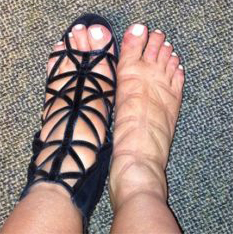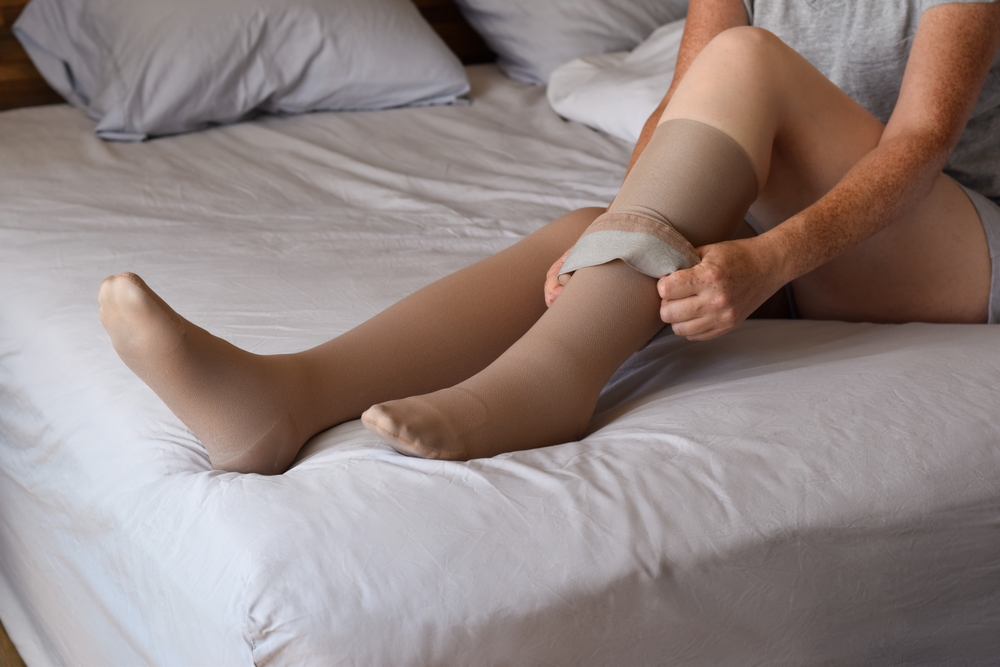Leg swelling, also known as edema, is a common complaint among individuals with vein disorders of the legs. This condition can arise from various causes, but one of the most frequent is chronic venous insufficiency, where the vein valves in the legs become "leaky." When these valves don't function properly, blood and fluids pool in the lower extremities, leading to fluid seeping into the surrounding tissues. This typically results in swelling around the ankles and lower legs, which can worsen if left untreated. Fortunately, comprehensive evaluations and effective treatment options for leg swelling are available at Inovia Vein Specialty Centers.
What Causes Leg Swelling?
There are a variety of causes of leg swelling. One hint of the cause can be considered when considering if the swelling is one sided (unilateral) or both (bilateral).
Also, it can help to understand if the swelling is new (acute) or has been around for a while (chronic). Finally, it helps to understand if it gets better at night, or is always the same. A vein specialist can take a history and do physical exam and learn a lot about the possible causes of swelling.

Call 1-800-834-6362 to Schedule a Consultation or Use Our
Is Leg Swelling a Serious Problem?
Leg swelling can be serious. Because some causes of leg swelling are related to other serious health problems, it is important to know which signs to look out for. We recommend that you seek an immediate medical evaluation if there is:
- A rapid onset of swelling in one or both legs (less than 72 hours), which can indicate deep vein thrombosis. Rapid swelling in both legs can also suggest an issue with the kidneys, heart, liver, or thyroid.
- A large amount of swelling in one or both legs, which can indicate a blood clot or tumor.
- Redness, warmth, leg pain, or skin ulceration, when the swollen leg should be checked for blood clots and infection..
- Extreme pain in a swollen leg that looks pale or feels numb, as the swelling may be cutting off circulation to the leg.
- Swelling combined with other concerning symptoms, like dizziness, weakness, shortness of breath, and/or chest pain, as these may be a sign of pulmonary embolism or a serious heart, kidney, liver, or thyroid condition.
Diagnosis & Treatment for Leg Swelling

Our area of expertise is the medical evaluation, often with diagnostic ultrasound of the veins, and then discussions with our vein experts to discuss options to treat the poorly functioning veins when indicated.
Generally, a commonly prescribed approach for edema treatment is movement, compression, and elevation. Other approaches include manual lymphatic drainage and decongestion therapy from certified lymphatic massage specialist and pneumatic compression pumps for some patients on a long-term basis.
Minimally invasive office-based vein treatments can help reduce swelling over the long term in some patients.
Why Choose Inovia Vein Specialty Centers
Inovia Vein Specialty Centers was founded with a mission to bring expert, minimally invasive vein care directly to the communities that need it most. Unlike many vein specialists who operate in hospitals with higher fees and added complexity, our treatments are performed entirely in-office using the latest outpatient techniques. This office-based model enables us to provide care that is affordable, convenient, and centered on the patient's experience from start to finish.
Since opening our first clinic in Bend, OR, in 2006, we've grown to become the largest vein-focused healthcare provider in the Pacific Northwest, with locations throughout Oregon and Southwest Washington. Our board-certified vein specialists offer decades of trusted experience and are committed to using the most advanced, evidence-based treatments, including innovations like VenaSeal, which we were the first to introduce in Oregon. With a strong track record of leadership, clinical research, and international education, the Inovia team partners with each patient to deliver safe, effective results with compassion and clarity.
Frequently Asked Questions
Leg Pain & Swelling
There are many home remedies for edema and many experts who can help guide patients to the best approach. As medical doctors specializing in vein care, we often collaborate with naturopaths and other experts in home remedies but defer to their expertise on this subject. Our area of expertise is the medical evaluation, often with diagnostic ultrasound of the veins, and then discussions with our vein experts to discuss options including procedures to treat the poorly functioning veins when indicated.
Reducing swelling in the feet is similar to reducing swelling in the legs. Movement, compression, and elevation is commonly prescribed. Other approaches include manual lymphatic drainage and decongestion therapy, pneumatic compression pumps, minimally invasive vein treatments, and/or treatment of heart or kidney problems. The right approach will depend on the patient and the cause of the swelling.
When the cause of swelling is medical, such as in patients with heart failure or kidney failure, treatment of the heart and kidney problems - including diuretics to promote urination of extra fluid - can help. Seeking a consultation with a qualified medical provider is recommended.
Just one leg swelling is even more of hint that the problem is local (in the leg) rather than systemic (from the heart, kidneys or liver, for example). Local problems can include chronic venous insufficiency (Varicose veins), deep venous thrombosis (DVT) or lymphedema. Of course there are exceptions to every rule, as one can have venous swelling in both legs if each leg has venous issues. There is a less common compressive syndrome called May Thurner Syndrome (MTS) where there is compression of the left sided pelvic veins leading to swelling or blood clots. Sorting out the causes and thus the treatments for leg swelling can be complex and thus seeking a consultation with a vein expert can be helpful.
When one is standing, gravity is pulling fluid toward the floor. Thus any extra fluid will go to the legs. Patients with leg vein problems - and lymphedema in particular - develop leg swelling, especially as the day goes on. Once the patient gets out of bed, the pressure builds in the lower leg. Severe swelling might start right away. More moderate swelling might not manifest until later in the day. More mild swelling might not appear until the end of a long day standing. Once the patient goes to sleep laying down in bed, the fluid dynamic is reversed and the fluid can be reabsorbed and the swelling goes down at night . This pattern is quite typical of chronic venous insufficiency, in particular.
If you press a swollen area with your finger and it doesn’t cause an indentation in the skin, it’s considered non-pitting edema. If it causes an indentation, its called pitting edema. Pitting vs non pitting edema can offer the care provider hints as to the potential cause or causes of leg swelling.
If you are unsure what is going on, it never hurts to seek a professional opinion from a provider to assess the possible causes. If this has been going on for a long time, it is a less urgent issues. If its rapid in onset, the concern for a DVT or other medical conditions is higher and one might need to seek urgent medical evaluation or go to the emergency room.
Yes, leg swelling can come and go, especially in the early stages of venous insufficiency or when triggered by prolonged standing, travel, or heat. Fluctuating swelling may also occur due to diet (e.g., high salt intake), hormonal changes, or certain medications. However, even intermittent swelling can be a sign of underlying vein disease, so it's important to get evaluated if the condition persists or worsens over time.
Yes, pregnancy can cause leg swelling due to higher blood volume, hormonal changes, and pressure on the pelvic veins. These factors can impair normal blood return from the legs, contributing to venous insufficiency and varicose veins. Many women experience temporary swelling during pregnancy, but for some, vein-related issues may persist or worsen postpartum.
Absolutely. Excess body weight places additional pressure on leg veins, which can damage or weaken vein valves over time. This increases the risk of chronic venous insufficiency, leading to pooling of blood and fluid in the lower extremities. Obesity is a known risk factor for both developing and worsening vein disease and related leg swelling.
Compression stockings are a highly effective, non-invasive tool for managing leg swelling. They help support vein function by applying graduated pressure to the legs, which promotes better blood flow and prevents fluid from accumulating in the tissues. While they don't cure the underlying condition, they can significantly relieve symptoms.
Say Goodbye to Leg Swelling with Expert Vein Care in Portland, OR
If leg swelling or vein discomfort is affecting your daily life, the trusted team at Inovia Vein Specialty Centers is ready to help. Call us today at 1-800-834-6362 to schedule your consultation.